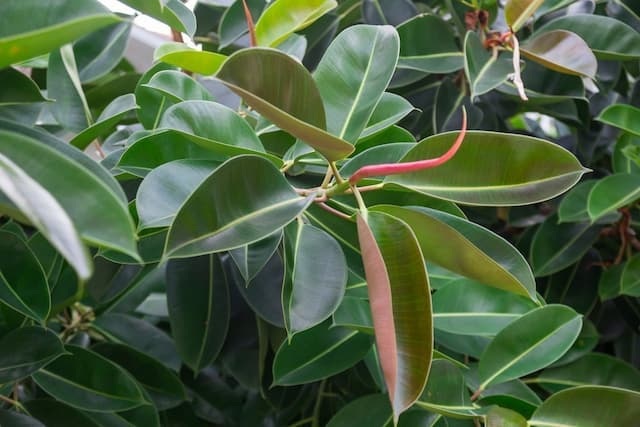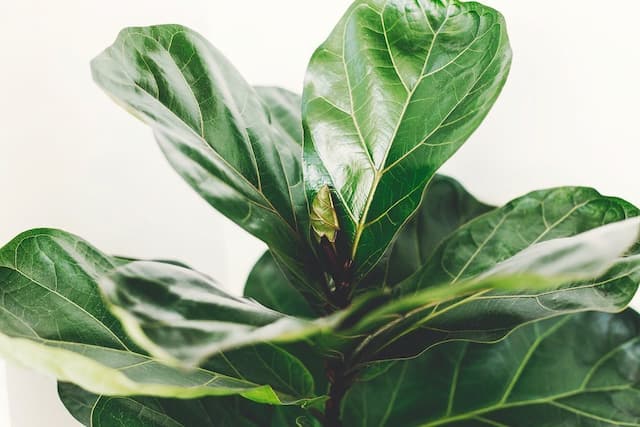Common Fig 'Panachée' Ficus carica 'Panachée' (F)
ABOUT
'Panachée' is a compact, deciduous small tree or shrub and an ancient variety of fig with round, dark green leaves. Bright striped yellow and green fruit with crimson, strawberry flavoured flesh appear in late summer. Insignificant flowers are produced in late spring or early summer.
About this plant
 Names
NamesFamily
Moraceae
Synonyms
Variegated Fig, Panache Tiger Fig, Striped Tiger Fig
Common names
Ficus carica 'Panachée'
 Characteristics
CharacteristicsLife cycle
Perennials
Foliage type
Deciduous
Color of leaves
Mixed
Height
10 feet [3 meters]
Spread
10 feet [3 meters]
Plant type
Tree
Hardiness zones
8
Native area
Western Asia Mediterranean
Benefits
 General Benefits
General Benefits- Ornamental Appeal: Ficus carica 'Panachée', commonly known as the Variegated Fig, has striking variegated leaves that add visual interest to gardens and landscapes.
- Fruit Production: It produces edible figs that can be enjoyed fresh, dried, or used in cooking and baking, providing a source of home-grown food.
- Shade Provider: With its broad canopy, the Variegated Fig can offer shade in sunny gardens, creating cooler areas during hot weather.
- Habitat Support: The tree can provide habitat and food for wildlife, including birds and beneficial insects.
- Drought Tolerance: Once established, it is quite drought tolerant, reducing the need for frequent watering and making it suitable for xeriscaping.
- Soil Enrichment: The tree can enhance soil fertility through leaf drop, contributing to a natural mulch that enriches the soil as it decomposes.
 Medical Properties
Medical Properties- Laxative effects: The fruit of the common fig, which Ficus carica 'Panachée' is a variety of, is known for its high dietary fiber content that can help promote healthy bowel function.
- Antioxidant content: Figs have been reported to contain antioxidants like flavonoids and polyphenols, which may contribute to reducing oxidative stress in the body.
- Anti-inflammatory properties: Some studies suggest that fig extracts may exhibit anti-inflammatory effects, potentially useful in managing inflammation-related conditions.
- Prebiotic activity: The fiber in figs can act as a prebiotic, providing nourishment for beneficial gut bacteria, aiding digestive health.
- Potential anti-cancer properties: While not a treatment, some research indicates that compounds in figs may have potential anticancer properties.
- Blood pressure regulation: Figs contain potassium, which can help in maintaining normal blood pressure levels.
- Blood sugar control: Some elements in figs may have a role in modulating blood glucose levels, although their effect is not fully understood.
 Air-purifying Qualities
Air-purifying QualitiesThis plant is not specifically known for air purifying qualities.
 Other Uses
Other Uses- Bonsai Cultivation: Ficus carica 'Panachée' can be trained as a bonsai due to its attractive form and foliage, creating a miniaturized but realistic representation of a full-sized tree.
- Leaf Impressions: Leaves of the fig tree can be used to create natural patterns or impressions in pottery and plaster, capturing the intricate vein structures as artistic decorations.
- Natural Dyes: The leaves and fruits can provide natural dyes for textiles, offering shades of yellow, brown, or green, depending on the mordant used.
- Baking Enhancement: Dried fig leaves can impart a coconut-like flavor when used to line the baking tin for breads and cakes.
- Culinary Wrapping: The large leaves can be used to wrap food for grilling or steaming, adding a subtle flavor and helping to retain moisture in the food.
- Garden Texture: With its variegated foliage, the plant adds visual interest and texture to garden landscapes or as part of mixed border plantings.
- Vegan Cheese Making: Fig leaves can be used in vegan cheese making to wrap the cheese, helping to form a rind and infuse flavor.
- Handicrafts Materials: The wood and leaves can be used in making small handicrafts or as decorative elements in floral arrangements.
- Photography Prop: The distinctive leaves and fruits may serve as a beautiful, natural prop or backdrop in botanical and food photography.
- Printmaking: The textured surface of fig leaves can be used in printmaking to create organic and botanical prints on paper or fabric.
Interesting Facts
 Feng Shui
Feng ShuiThe Variegated Fig is not used in Feng Shui practice.
 Zodiac Sign Compitability
Zodiac Sign CompitabilityThe Variegated Fig is not used in astrology practice.
 Plant Symbolism
Plant Symbolism- Knowledge and Wisdom: Ficus carica 'Panachée,' better known as Striped Tiger Fig, often symbolizes knowledge and wisdom, reminiscent of the fig tree's association with enlightenment and learning, as it has biblical ties to the story of Adam and Eve, where the fig leaf represented awareness.
- Fertility and Abundance: The fig fruit's numerous seeds and luscious interior are frequently seen as a symbol of fertility and abundance, celebrating growth, reproduction, and natural bounty.
- Peace and Prosperity: Historically, the fig tree has been a symbol of peace and prosperity, with its abundant fruit suggesting a life of satisfaction, harmonious existence, and well-being.
- Longevity and Resilience: With its ability to grow in tough conditions and live for many years, the fig tree embodies longevity and resilience—a testament to enduring through challenges and the passage of time.
 Water
WaterThe Panache fig should be watered deeply but infrequently, allowing the soil to dry out slightly between waterings. In the active growing season, typically once a week suffices, but this can vary based on climate and soil conditions. Provide about 1-2 gallons of water for outdoor trees, ensuring it's distributed evenly around the root zone. During the winter dormant period, reduce watering frequency to every 2-3 weeks, depending on the weather. Always adjust watering habits to the plant's needs and local weather conditions, taking care not to overwater which can lead to root rot.
 Light
LightThe Panache fig thrives in full sunlight for at least 6-8 hours a day to produce the best fruit and to maintain a robust health. The ideal spot would be in a south-facing location where it receives ample sunlight throughout the day. Avoid locations where the tree would be in the shadow of larger trees or buildings, especially during the prime sunlight hours.
 Temperature
TemperatureThe Panache fig prefers a temperate climate with temperatures ranging between 15-85 degrees Fahrenheit. It can tolerate temperatures as low as 20 degrees Fahrenheit for short periods, but frost can be harmful. The ideal growing temperatures are between 60-80 degrees Fahrenheit during the growing season, with temperature moderation being important to avoid stress on the plant.
 Pruning
PruningPrune the Panache fig during dormant winter months to remove dead or weak branches, to shape the tree, and to promote new growth for better fruit production in the coming season. Pruning should be done annually; however, heavy pruning should be done sparingly and only as necessary to maintain the health and structure of the tree. The best time for major pruning is late winter, just before spring growth begins.
 Cleaning
CleaningAs needed
 Soil
SoilThe best soil mix for a Variegated Fig should be rich, well-draining, and contain organic matter. A good recipe would be one-part compost, one-part perlite, and two parts loam. Aim for a soil pH between 6.0 and 6.5 for optimal growth.
 Repotting
RepottingVariegated Figs should be repotted every 2-3 years to replenish the soil and allow room for growth. It's best to repot in late winter or early spring before the new growth begins.
 Humidity & Misting
Humidity & MistingVariegated Figs prefer moderate humidity levels, ideally between 40-50%. They can tolerate lower humidity, but consistent levels within this range are best for their growth.
 Suitable locations
Suitable locationsIndoor
Place in bright, indirect light and water when topsoil feels dry.
Outdoor
Full sun to partial shade, protect from strong winds and frost.
Hardiness zone
8-10 USDA
 Life cycle
Life cycleThe Ficus carica 'Panachée', commonly known as the Variegated Fig, begins its life cycle as a seed, which after successful germination, grows into a seedling with characteristic variegated leaves. As the plant enters the vegetative stage, it develops a robust root system and a sturdy trunk, while continuing to expand its canopy of large, lobed, and attractively patterned leaves. When it reaches maturity, the Variegated Fig starts the reproductive phase by producing small flowers enclosed within a structure called a syconium. Following pollination, typically by specific fig wasps, the syconium develops into the fruit for which the plant is cultivated; the figs exhibit green and white stripes and are edible when they ripen. Over time, the tree may enter a period of dormancy, especially in cooler climates, marked by leaf drop and reduced growth during colder months. After many years, as the tree reaches the end of its life span, it will slow its production of fruits and foliage until it eventually dies.
 Propogation
PropogationPropogation time
Spring-Early Summer
The most popular method of propagating Ficus carica 'Panachée', commonly known as Variegated Fig, is through cuttings. This is typically done in late winter to early spring before new growth begins. To propagate by cuttings, a gardener would take a 6 to 10 inch (15 to 25 centimeters) long cutting from a healthy branch, making sure it has at least two or three nodes. The bottom end of the cutting is then dipped in rooting hormone to stimulate root growth and planted in a mixture of peat and perlite or a well-draining potting mix. The cutting should be kept moist but not soggy and placed in indirect light until roots have developed, which usually takes a few weeks. Once rooted, the cutting can be transferred to a more permanent pot or outdoor location depending on the climate.




